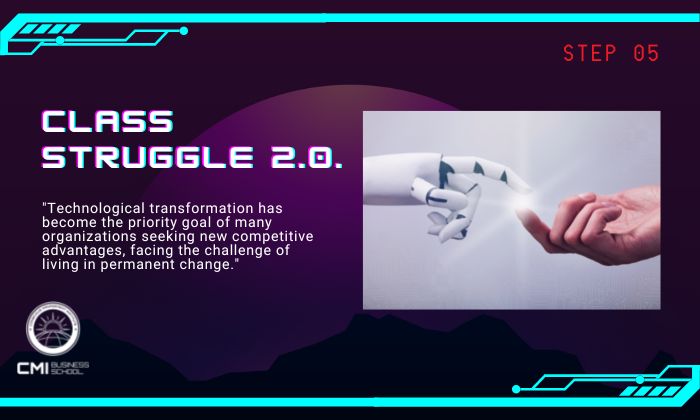CLASS STRUGGLE 2.0.

Today, we live in an intense and continuous overlap of disruptive innovations. In fact, technological transformation has become the priority goal of many organizations seeking new competitive advantages, facing the challenge of living in permanent change. The result of this new reality is an exponential intensification of the presence of technology in the day to day of organizations and in people’s lives.
Certainly, the growing presence of technology is non-negotiable, so it is worth wondering if this situation can lead to a dehumanization of organizations: is modernization causing their progressive impoverishment? Is there a real risk of shifting the center of gravity from people to machines?
Technology can and should serve to improve people’s lives and contribute to the success of organizations. For this reason, people and machines are condemned to understand each other and our coexistence, far from a new class struggle, must be considered in terms of complementarity. It is the People friendly technology challenge in which each individual person, and each organization, must strive to play a leading role.
But this goal is not achieved by magic. Conscious work is needed; a continuous effort aimed at fitting the pieces of the puzzle together. People cannot compete with technology in matters such as data capture and analysis, or in relation to numerical calculation. And, focusing on the other side of the coin, it would not be logical for those responsible for organizational management to place all those issues that, from a humanistic perspective, exceed the capabilities of artificial intelligence in the hands of algorithms.
As has been pointed out, the technological transformation of organizations must be a way of life, of facing the reality of their day to day. It is not about resolving specific situations or specific challenges, it is about accepting that permanent change is the new context in which the organizational purpose must come true. Achieving this objective can be difficult and, for this reason, a firm and conscious decision to maintain a strategic approach based on the centrality of people is unavoidable.
In fact, this approach is presented as the only way to maintain a correct course among the ups and downs of the current context of permanent technological disruption. Undoubtedly, it is an exciting challenge that is not necessarily complicated because it is difficult. It is enough to be clear and be consistent with some fundamental principles. What are those basic principles that ensure peaceful coexistence, and mutual enrichment, between people and technology?
1st. The resolution of ethical dilemmas can only be successfully carried out through human consciousness.
2nd. Decision-making, although supported by the information and analysis that technology can offer, especially artificial intelligence, must be limited to the sphere of responsibility of people.
3rd. The emotional balance and, consequently, the well-being of people, is built from human relationships, so it would not be appropriate to replace them with interactions with tools outside this field.
From my point of view, respecting these three golden rules guarantees an adequate context to achieve the necessary centrality of people, reserving for them what is their own, while maximizing the contribution of technological tools to the rest of the fields of organizational activity.
Prof. Dr. Cristóbal Táuler San Miguel
